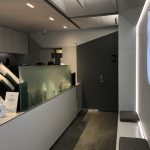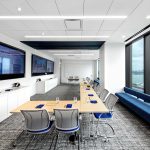Employees Come First: How New Antimicrobial LED Technology Reopens Offices Under the Right Light

Editor’s Note: This article originally appeared in Electrical Line Magazine. See the original story here.
What’s the best way for companies to reopen their offices and protect their most valuable resources—their staff?
Today, corporate leadership and boardrooms are in dire search of the answers to that very question as their employees’ comfort level and their company’s productivity hang in the balance.
In April 2020, just a few weeks into the world’s largest telecommuting experiment, a poll by Eagle Hill revealed that most employees were extremely apprehensive about their exposure to pathogens including coronaviruses in their workplaces. About a year later, when Eagle Hill did a similar poll, a new set of survey participants expressed greater confidence, but a series of uh-oh asterisks and employee concerns remained. Close to half wanted their employers to delay their office reopening plans, and most wanted their employers to remain vigilant in adhering to the strictest of health recommendations—continuous disinfecting efforts included.
For decision-makers at all buying levels—from architects and facility managers to purchasing agents and end-users—these findings suggest it’s imperative that workplaces offer an extra layer of protection against viruses, bacteria and other infectious diseases.
Such an approach will require a new, adaptive way of deep cleaning and sterilizing, one that goes well beyond extra scrubbing from the nightly cleanup crew.
Lighting’s New Office Role
Thanks to recent advancements in LEDs, there’s an innovative approach to mitigating such contamination. Called white, UV-free antimicrobial LED lighting, the new lighting technology has quickly become an attractive and valuable asset for offices wanting to provide a cleaner, healthier inhospitable space for bacteria and viruses, including SARS-CoV-2, which causes COVID-19, according to recent third-party analysis.
This next generation of germicide illumination is internationally approved for continuous use around people and supplements cleaning crew efforts by reducing the bioburden—the number of microorganisms living on a surface yet to be sanitized—in all those high-touch, high-volume spaces such as kitchens, bathrooms, conference rooms and waiting areas. Each setting, research shows, was a breeding ground for microbes long before the pandemic upended the daily hustle and bustle of commercial office spaces.
In addition to incessantly disinfecting already cleaned-off surfaces, antimicrobial lighting also checks off frequently overlooked items such as doorknobs or objects on desks that the cleaning crews are told to avoid. Think, for instance, phones, keyboards and computer mice.
Studies Reveal How Infectious Diseases Spread Easily Inside Offices
Research time and again shows that employees who work at an office collect “more than a paycheck.” They also collect bacteria, viruses and other pathogens—lots of them, with the average office desk yielding some 400 times more bacteria than what’s commonly found on a typical toilet seat.
Additional investigation by the University of Arizona revealed equally disturbing conclusions. The average desk, researchers there say, has more than 10 million bacteria organisms, with men reportedly having three to four times more bacteria on their desks than their female colleagues. Why? The reasons varied, the study showed, including how men tend to have lower levels of desk hygiene as well as larger desks for viruses and bacteria to accumulate.
Perhaps more alarming: Germ-infested doorknobs and tabletops can spread pathogens up to 60% of an office’s staff within two to four hours. No wonder employees take an average of 4.9 sick days off each year, according to a PwC analysis. For a company of 100 workers, that’s 490 days lost due to sickness that could be linked to the office. Sick days add up fast—and it’s a total productivity zapper.
Researcher Kelly Reynolds, a professor and environmental microbiologist at the University of Arizona, explained this damaging domino effect in the clearest of terms just after the release of her report: “We touch a lot of different surfaces that hundreds of others might be touching. Germs spread quickly.”
And even the greatest of scrubbing efforts by professional cleaners can only do much for so long.
Research shows bacteria counts are the lowest just after cleaning has been completed. That was traditionally at the start of a workday because offices were cleaned the night before. Today, with cleaning efforts increased, that could be at multiple times throughout the workday. Still, it doesn’t take long for bacteria to return. In fact, all it takes is the arrival of a single person to reverse the last deep cleaning effort. “As the day ramps up and more people touch more surfaces, the risk of encountering bacteria goes up,” Reynolds explained.
Soap and water, Reynolds says, are traditionally not strong enough to kill all bacteria, viruses and other infectious diseases on surfaces. “You need to use a product with a disinfectant,” she advised. This is where the right touch of light can shine a purifying glow. But if managers and facility managers want to keep their operations pacing along without a pause, the first disinfectant light that likely comes to mind is not the way to go.
Why UV Lighting Can Cause Business Disruptions
Offices worldwide have shifted their focus to researching state-of-the-art, hospital-grade technologies to better protect their workforce from the fast growth of microorganisms and the looming infection threats they impose.
A common, go-to “solution” has been investing in and installing ultraviolet (UV) lighting, which closely mirrors the technological composition and disinfecting benefits of antimicrobial lighting. Both have powerful, well-documented disinfectant capabilities.
But the two are not the same.
The technologies used by antimicrobial light and the various branches of UV lighting differ in the technologies they use, the microorganisms they’re effective against, the way they kill microbes—even the applications they’re used in. Perhaps the most significant difference: One minimizes business disruptions; the other inevitably escalates them.
Here’s why: UV lighting is intrinsically dangerous. It essentially works as a harsh disinfectant, piercing a microbe’s nucleus and obliterating nucleic acids while disrupting DNA structures. The damaged DNA accumulates and leaves the cells unable to perform vital essential functions.
Prolonged exposure at high intensities harms the cellular structure in living things—humans included. Potential eye problems include cataracts, issues with the cornea and temporary or permanent loss of vision. UV lighting can also make it harder for the skin to heal, experts say. It can even cause cancer.
In other words, UV lighting is not suitable for extended periods of use when humans are present in a space. This undeniable factor explains why, for all the raving headlines UV lighting has generated over the last year, just as many have warned about its strict limitations and safety issues. Reports last year alerted workplaces about the potential eye damage UV lighting can cause, and a report about a robot at a greater Boston food bank that shined UV disinfectant lighting came with a glaring caveat: A built-in protection feature shuts off the robot’s UV cleaning function when movement or people is detected.
Both cautionary tales emphasize how it’s exceedingly challenging to vow endless disinfecting without any business disruptions when it comes to UV lighting.
Antimicrobial Lighting Continuously Disinfects Without Business Disruptions
UV-free antimicrobial lighting, on the other hand, can deliver such a guarantee.
The illumination meets the international standards for continuous and unrestricted use with people present by using wavelengths cluster around the 405-nanometer mark, which is safely above of the UV frequency range of 100 to 380 nanometers. More nanometers traditionally equal more wavelengths on the visible light spectrum, and the shorter the wavelengths below 380 nanometers, the greater the danger to living things.
Antimicrobial lighting’s extermination power comes from within the visible light spectrum, from 380 nanometers to approximately 750 nanometers. It activates certain types of porphyrin molecules in infectious microbial cells but not in human, plant or animal cells. When activated, the porphyrins produce excessive Reactive Oxygen Species (ROS), such as singlet oxygen, hydrogen peroxide and hydroxyl groups, destroying multiple structures within the infectious cell.
Unlike microbial cells, the types of porphyrin molecules found in humans and other animals are not photoactivated by illumination in the 400-to-420 nanometer range, which is why antimicrobial lighting technology is approved for continuous usage with worker bees crisscrossing underneath.
Similarly, white, UV-free antimicrobial lighting does not trigger the degradation of materials as traditional UV lighting does. UV rays can break down the chemical bonds found in plastics and cause fabric and other objects to fade in color and structure. Depending on the antimicrobial lighting system installed, other pluses include decreases in maintenance—regular bulb replacement and constant oversight become a thing of the past—and crisp, comfortable white ambient lighting free of any violet hue that simultaneously disinfects. Select systems also have two or more cleaning methods: one mode for when staff is present, the others for when they’re not.
With antimicrobial lighting, its varying cleaning modes require just two simple steps: First, set the system up using a preset, timer or sensor. Then, forget it. It’s good to go on its own.
Antimicrobial lighting shares all the disinfecting benefits of UV lighting, without the long-lasting harmful impacts or productivity-sucking side effects. It’s the specialized, round-the-clock sanitation service office workers see—but never feel.
How Antimicrobial Lighting Beats the Contamination Challenge Across the Office
Antimicrobial lighting has been tested in commercial applications worldwide, with its effectiveness constantly exceeding the 90% mark. In many instances, its efficacy has eclipsed the 99% threshold, depending on several factors including the light’s intensity, the amount of light reaching the surfaces, how the lighting is angled, the length of exposure time and how far away the lighting is from the surface.
For instance, a large corporate office witnessed a 92.4% bioburden reduction on five of the most commonly used surfaces in a breakroom—the toaster, refrigerator, sink, water cooler and trash can—after an antimicrobial clean lighting system was installed. A bathroom, per reports, experienced equally significant bacterial declines. Newly released research also underscores antimicrobial light’s knockout punch on non-enveloped viruses, which are the hardest class of viruses to kill. Examples of these types of viruses include the common cold, dysentery and polio.
Each of these case studies shares two additional characteristics: minimal business disruptions and no need to vacate the well-lit space.
Lighting has always been among the most prominent features in a dynamic work environment. Studies show that certain types of lighting can fundamentally impact employees’ mental and physical health. The National Lighting Bureau underscores research showing how lighting can influence mood, behavior and creativity. Certain types of lighting, the organization says, directly correlates with workers’ ability and desire to get projects and work completed. Cooler-temperature lighting—illumination between 4,000 Kelvin (K) and 7,000K—with higher intensities triggers greater productivity compared to warmer-temperature lighting with lower intensities.
But thwarting surface bacteria, viruses and infectious pathogens is a new leading role for commercial lighting.
Corporate leadership has long required good-quality lighting to boost employee productivity. With the integration of an antimicrobial lighting system, their overhead illumination could become the gateway to something more: A soothing illumination that welcomes back staff with the company’s commitment to a healthier, cleaner work environment under the right light.
Bill Plageman is the Vice President of Marketing and Product Development at Amerlux, an award-winning design-and-manufacture lighting company that is part of the Delta Electronics family of companies. With more than 25 years of lighting industry experience, Plageman has worked as a salesman, specifier and product manager prior to marketing. With today’s evolving technologies, Plageman has added another level of expertise to his job description: Educator. Informing and teaching his clients about the industry’s fast-emerging LED technologies and strategies is now his No. 1 priority.

